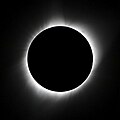| Total eclipse | |
| Gamma | −0.9737 |
|---|---|
| Magnitude | 1.0266 |
| Maximum eclipse | |
| Duration | 92 s (1 min 32 s) |
| Coordinates | 72°48′S155°06′E / 72.8°S 155.1°E |
| Max. width of band | 418 km (260 mi) |
| Times (UTC) | |
| Greatest eclipse | 20:40:23 |
| References | |
| Saros | 123 (49 of 70) |
| Catalog # (SE5000) | 9374 |
A total solar eclipse occurred at the Moon's ascending node of orbit on Thursday, October 12, 1939, [1] with a magnitude of 1.0266. A solar eclipse occurs when the Moon passes between Earth and the Sun, thereby totally or partly obscuring the image of the Sun for a viewer on Earth. A total solar eclipse occurs when the Moon's apparent diameter is larger than the Sun's, blocking all direct sunlight, turning day into darkness. Totality occurs in a narrow path across Earth's surface, with the partial solar eclipse visible over a surrounding region thousands of kilometres wide. Occurring about 1.8 days after perigee (on October 11, 1939, at 2:30 UTC), the Moon's apparent diameter was larger. [2]
Contents
- Eclipse details
- Eclipse season
- Related eclipses
- Eclipses in 1939
- Metonic
- Tzolkinex
- Half-Saros
- Tritos
- Solar Saros 123
- Inex
- Triad
- Solar eclipses of 1939–1942
- Saros 123
- Metonic series
- Tritos series
- Inex series
- Notes
- References
Totality was visible for a part of Antarctica. A partial eclipse was visible for parts of Eastern Australia, Oceania, extreme southern South America, and Antarctica.






































































































